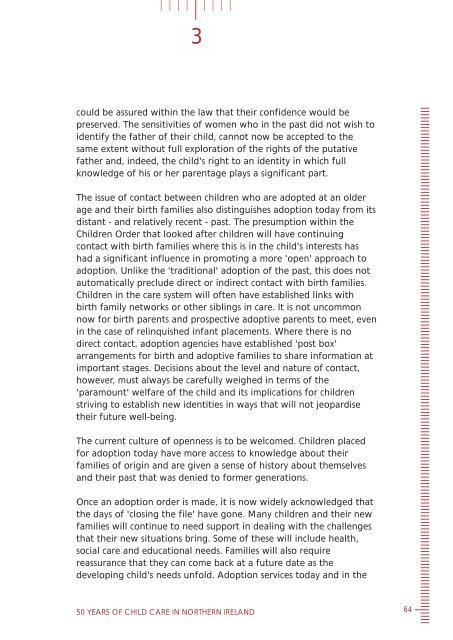childcare-50years
childcare-50years
childcare-50years
You also want an ePaper? Increase the reach of your titles
YUMPU automatically turns print PDFs into web optimized ePapers that Google loves.
3<br />
could be assured within the law that their confidence would be<br />
preserved. The sensitivities of women who in the past did not wish to<br />
identify the father of their child, cannot now be accepted to the<br />
same extent without full exploration of the rights of the putative<br />
father and, indeed, the child's right to an identity in which full<br />
knowledge of his or her parentage plays a significant part.<br />
The issue of contact between children who are adopted at an older<br />
age and their birth families also distinguishes adoption today from its<br />
distant - and relatively recent - past. The presumption within the<br />
Children Order that looked after children will have continuing<br />
contact with birth families where this is in the child's interests has<br />
had a significant influence in promoting a more 'open' approach to<br />
adoption. Unlike the 'traditional' adoption of the past, this does not<br />
automatically preclude direct or indirect contact with birth families.<br />
Children in the care system will often have established links with<br />
birth family networks or other siblings in care. It is not uncommon<br />
now for birth parents and prospective adoptive parents to meet, even<br />
in the case of relinquished infant placements. Where there is no<br />
direct contact, adoption agencies have established 'post box'<br />
arrangements for birth and adoptive families to share information at<br />
important stages. Decisions about the level and nature of contact,<br />
however, must always be carefully weighed in terms of the<br />
'paramount' welfare of the child and its implications for children<br />
striving to establish new identities in ways that will not jeopardise<br />
their future well-being.<br />
The current culture of openness is to be welcomed. Children placed<br />
for adoption today have more access to knowledge about their<br />
families of origin and are given a sense of history about themselves<br />
and their past that was denied to former generations.<br />
Once an adoption order is made, it is now widely acknowledged that<br />
the days of 'closing the file' have gone. Many children and their new<br />
families will continue to need support in dealing with the challenges<br />
that their new situations bring. Some of these will include health,<br />
social care and educational needs. Families will also require<br />
reassurance that they can come back at a future date as the<br />
developing child's needs unfold. Adoption services today and in the<br />
50 YEARS OF CHILD CARE IN NORTHERN IRELAND<br />
64


